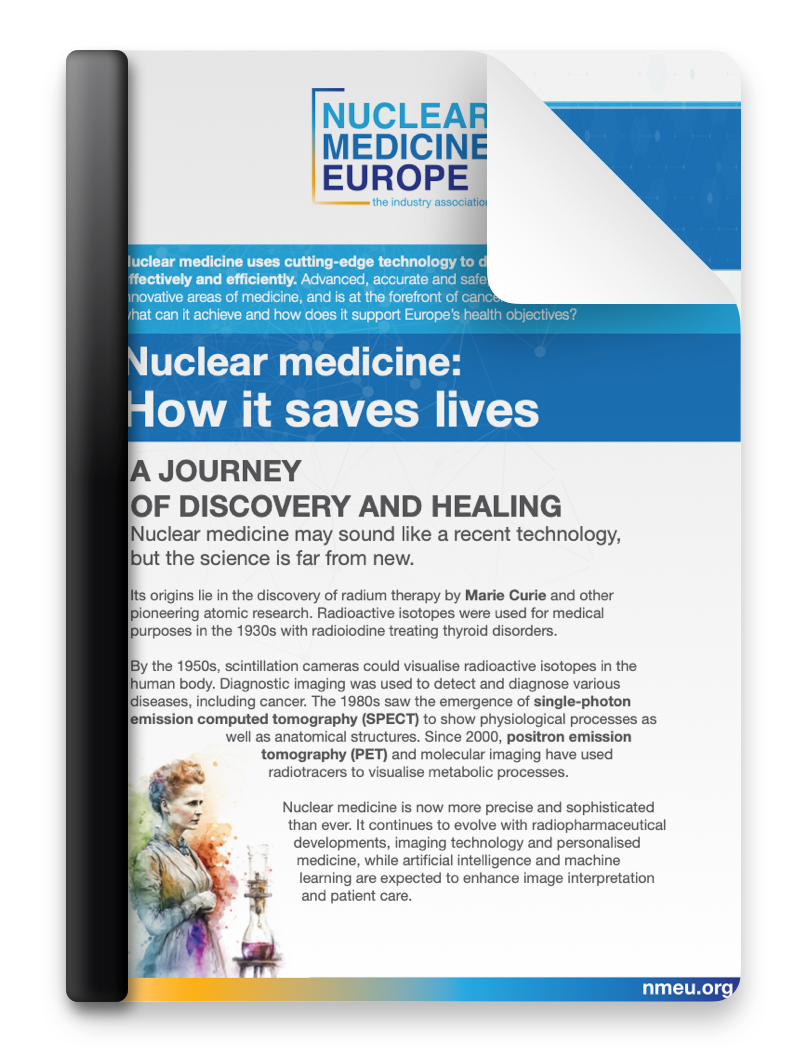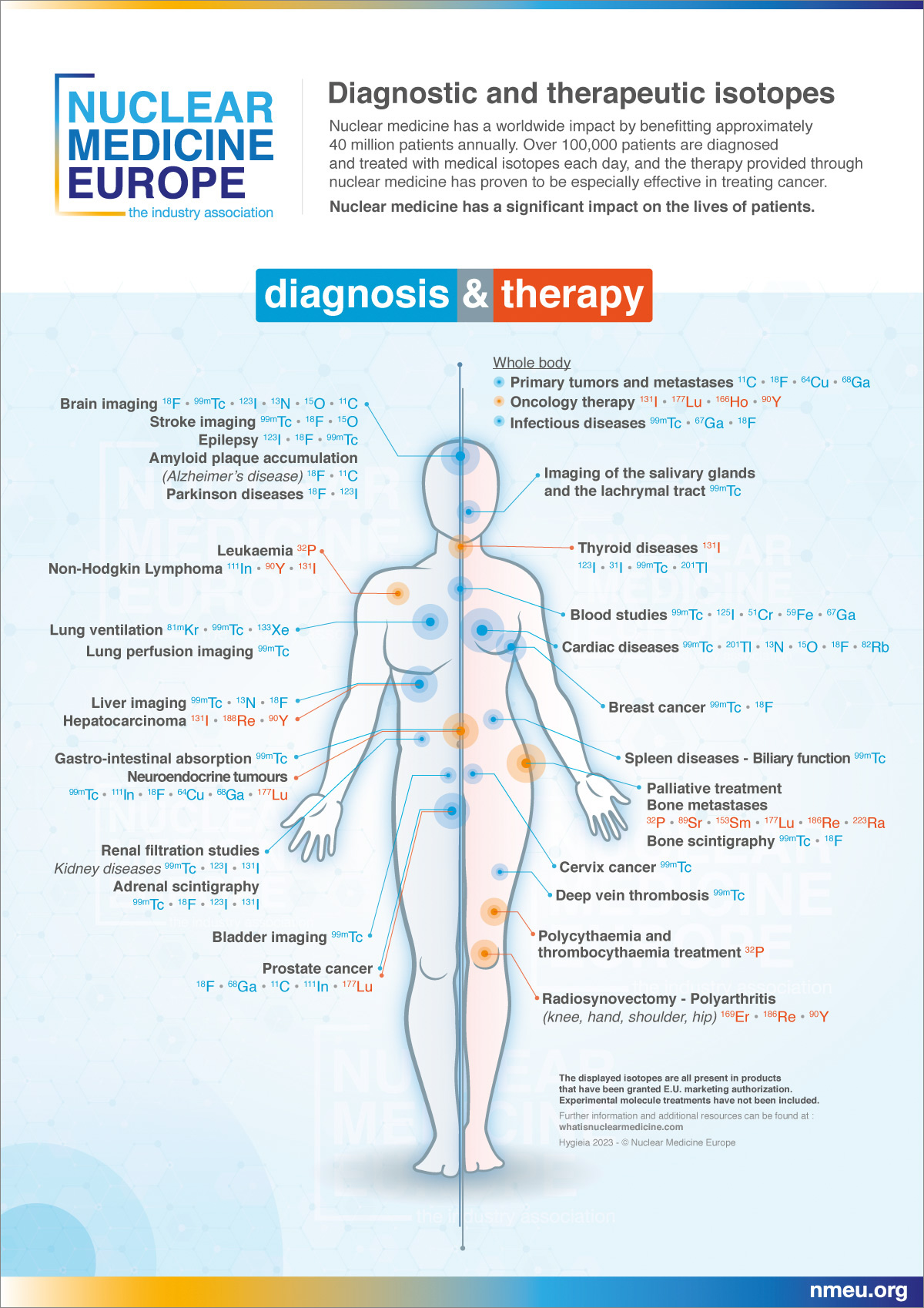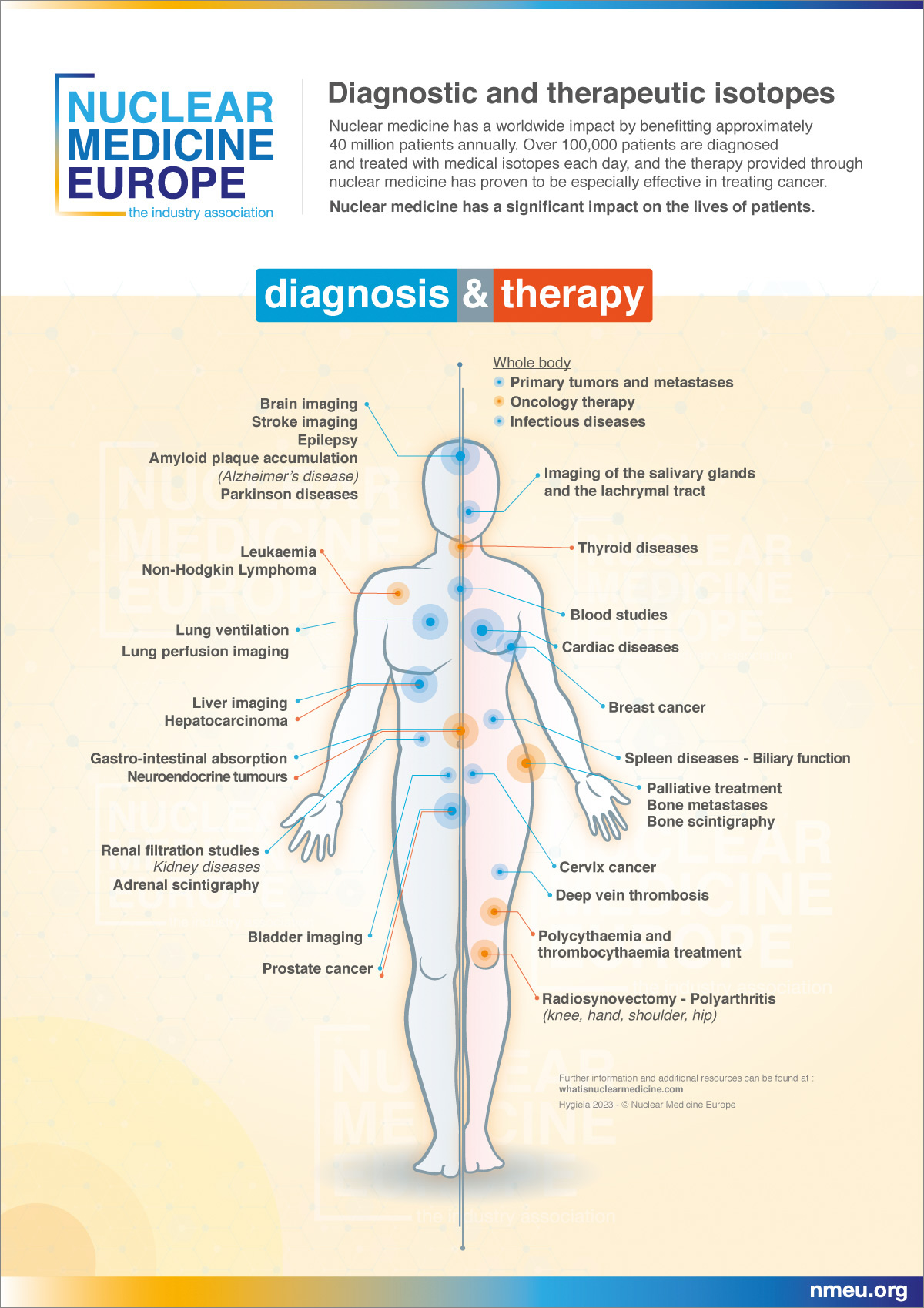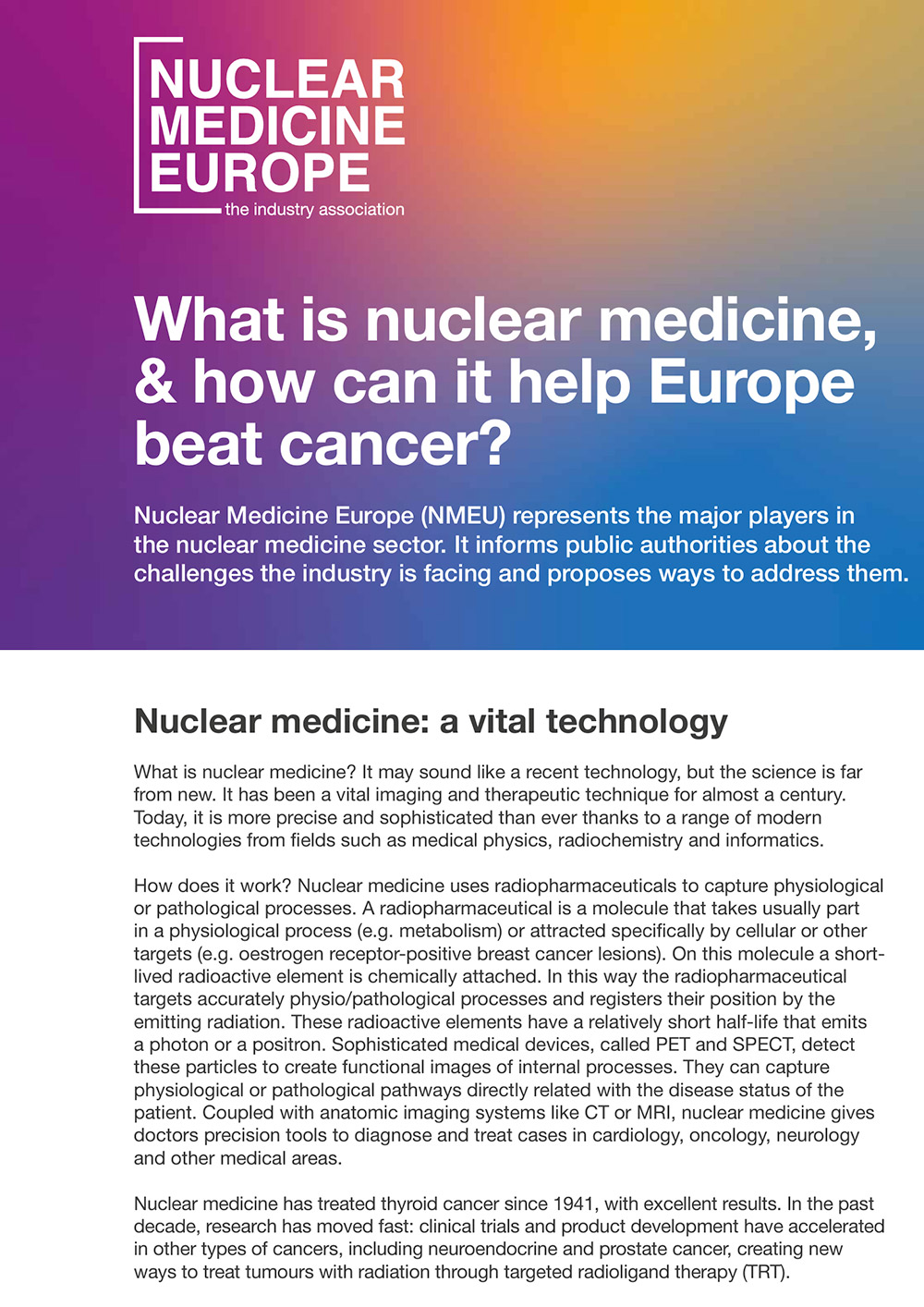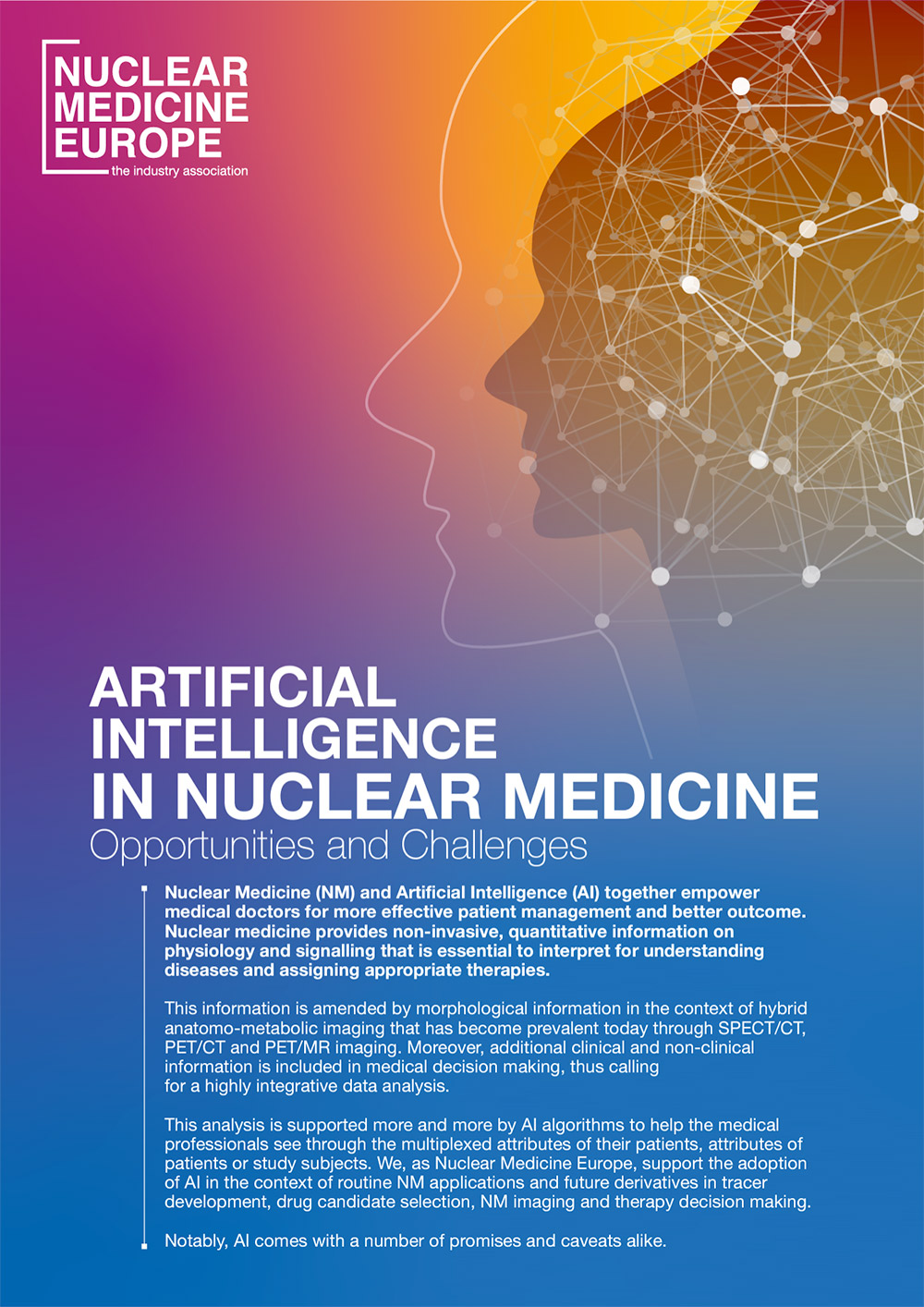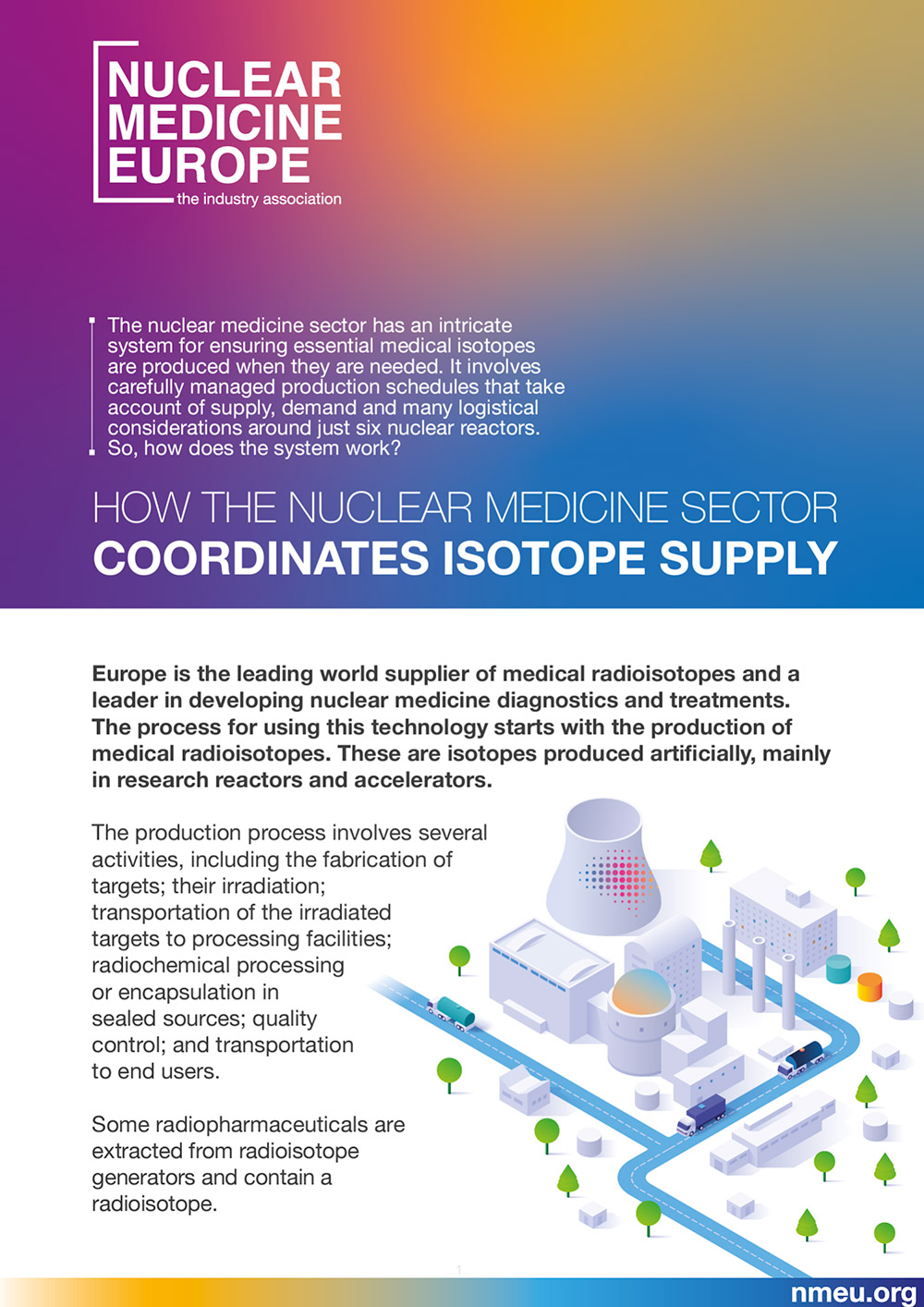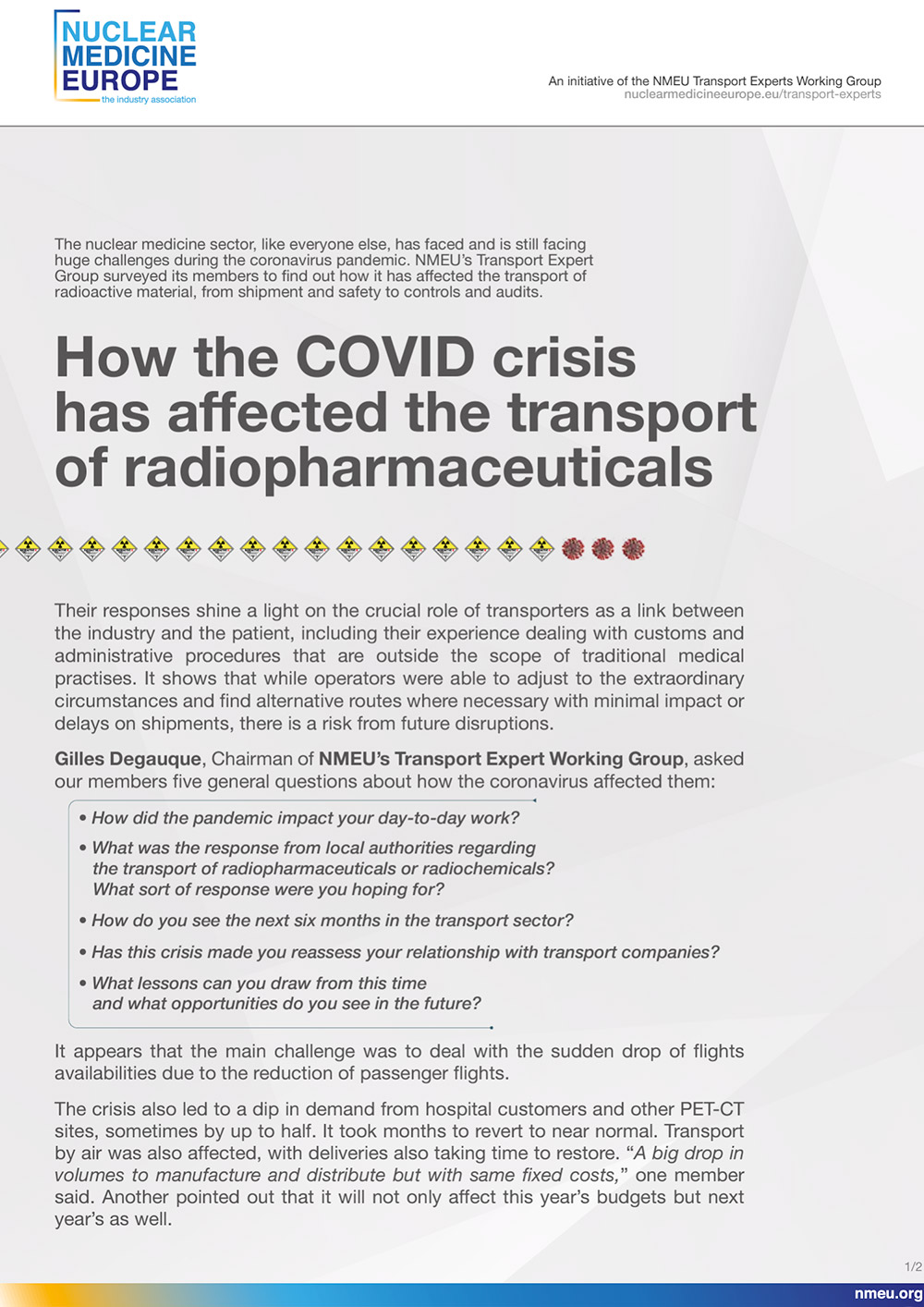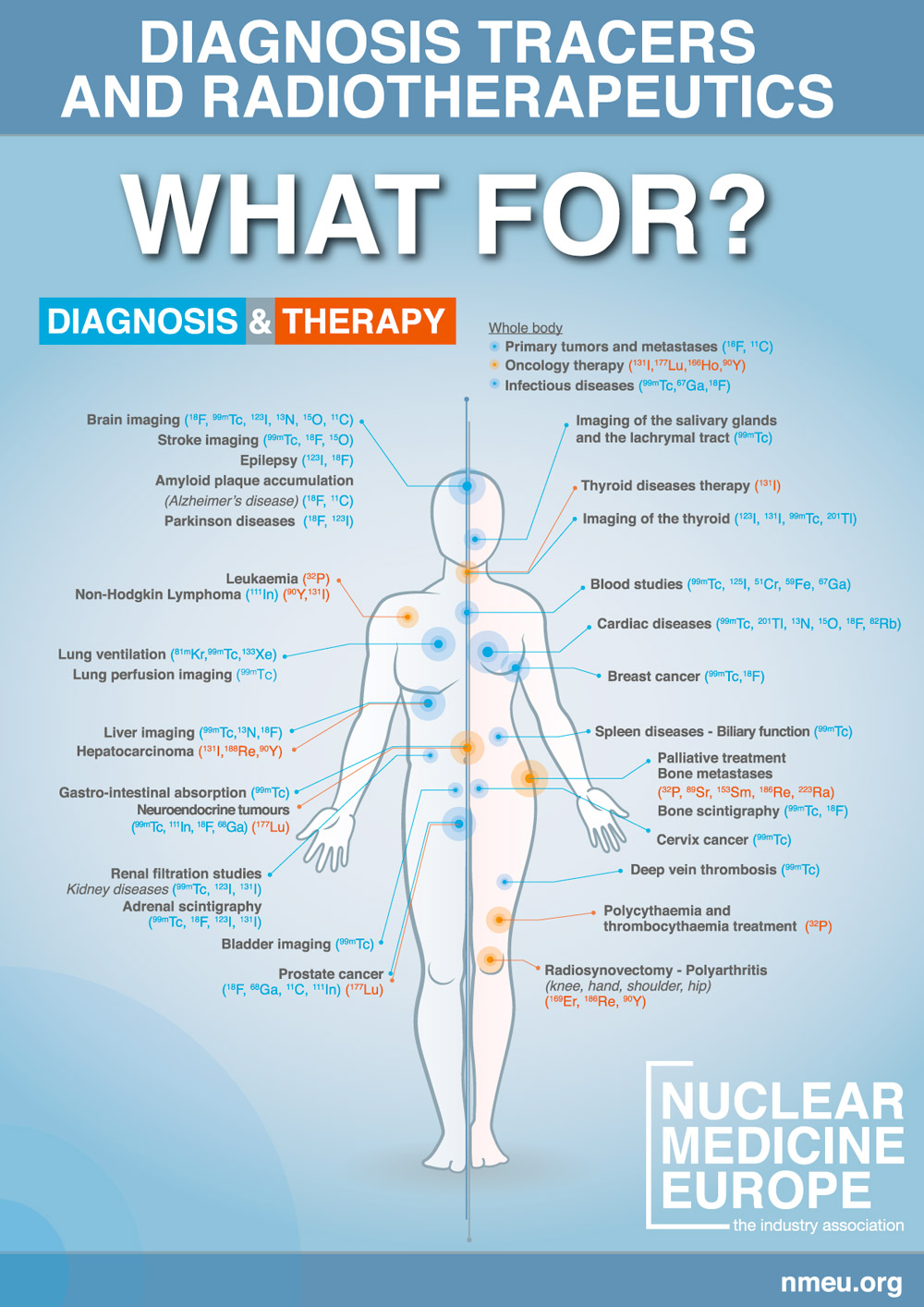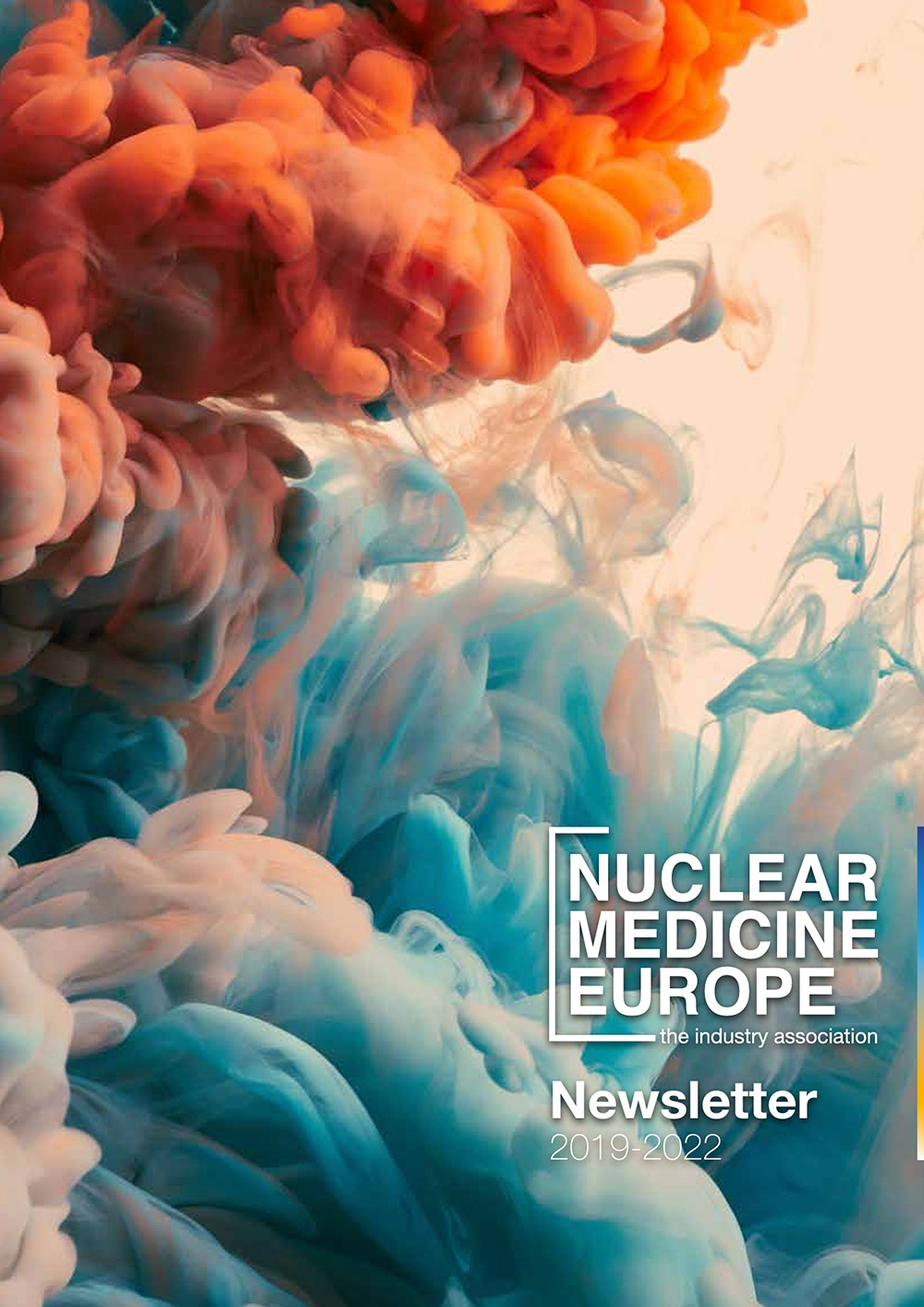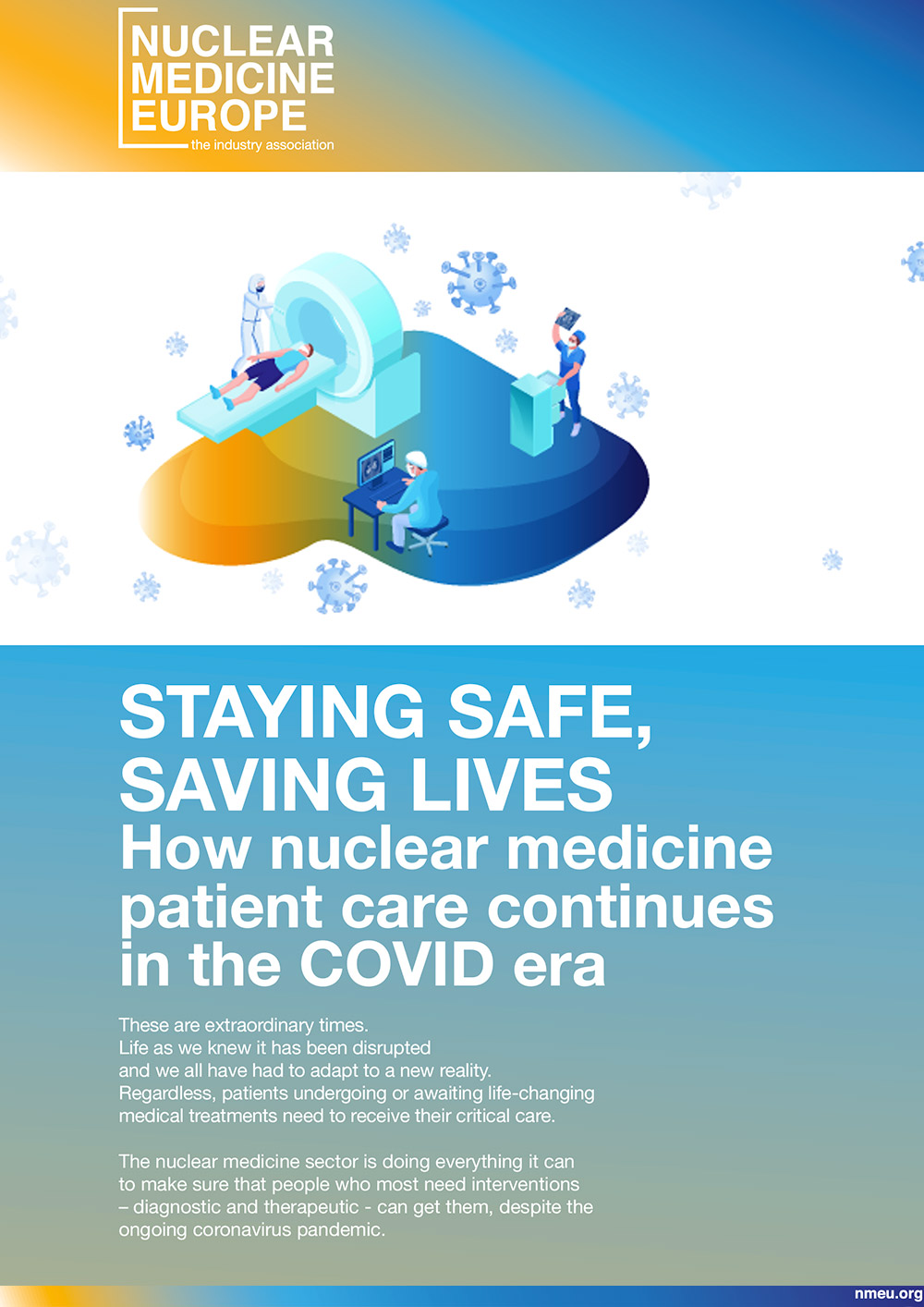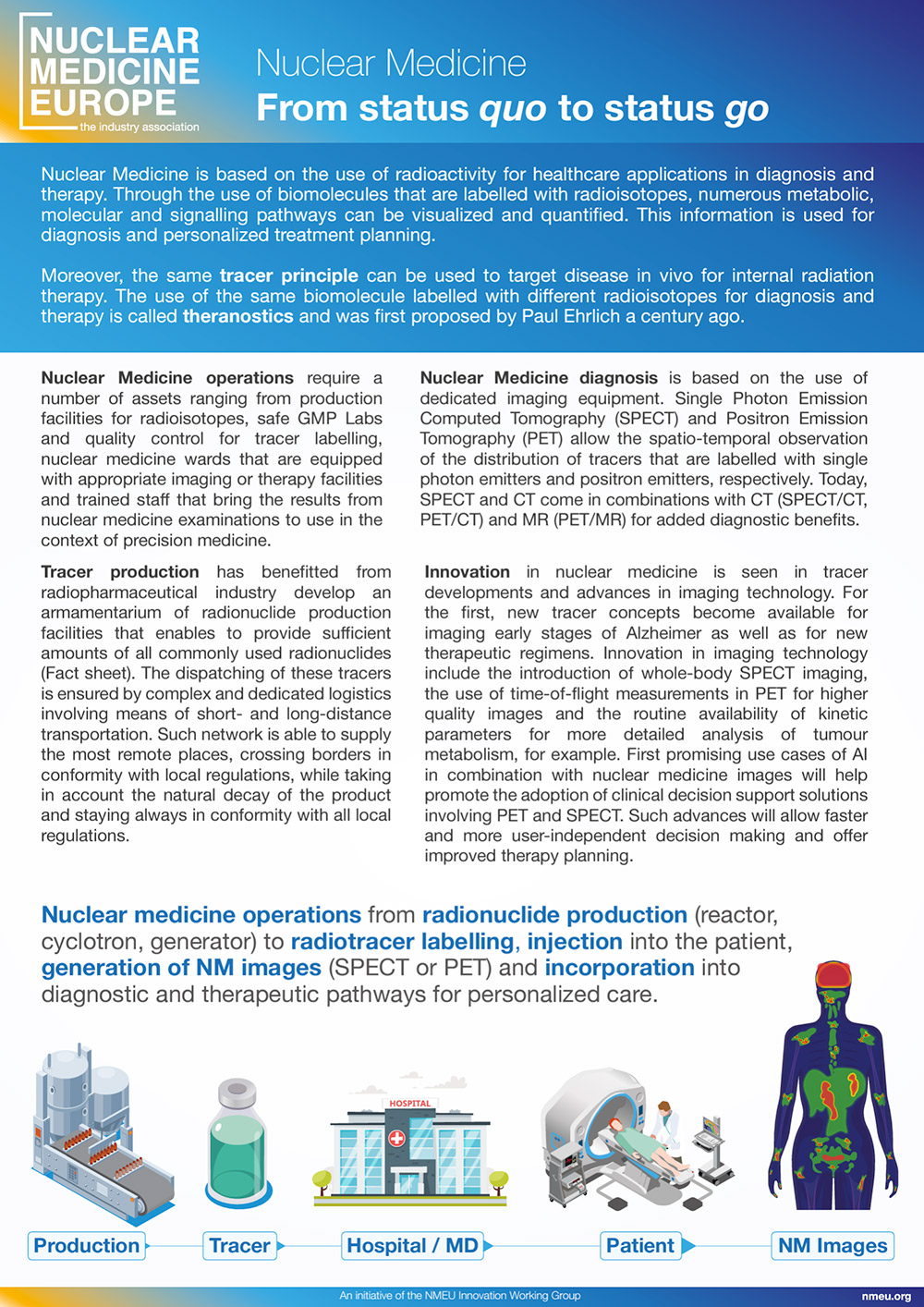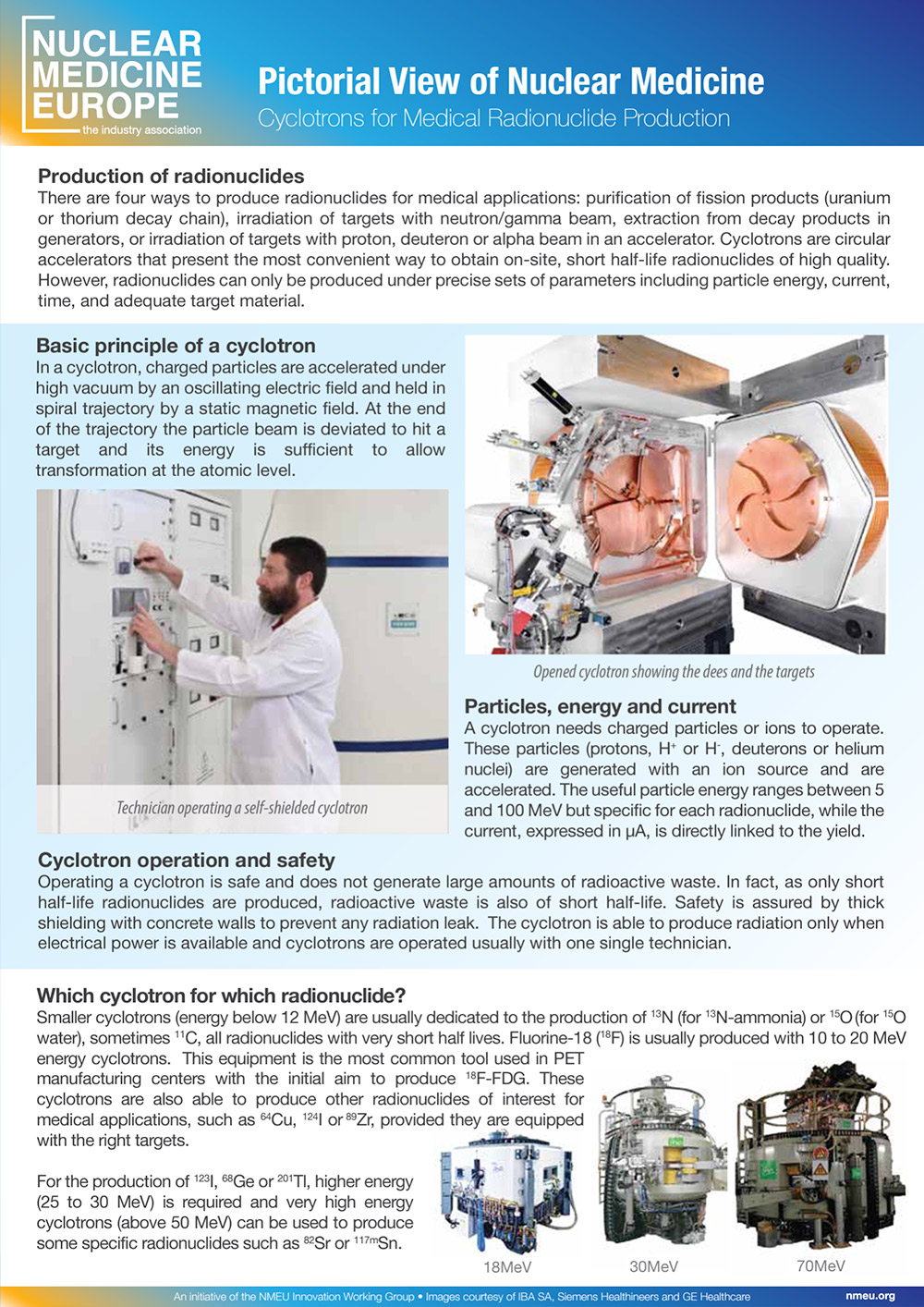Publications
Position Papers, Articles, Resources, etc.
Nuclear medicine: How it saves lives
“Nuclear medicine uses cutting-edge technology to diagnose and treat cancer effectively and efficiently. Advanced, accurate and safe, it is one of the most exciting, innovative areas of medicine, and is at the forefront of cancer treatment. How does it work, what can it achieve and how does it support Europe’s health objectives?”
A comprehensive introduction to nuclear medicine, which was made for the audience of the 2023 Nuclear Medicine Europe’s Symposium, was held at the European Parliament.
Click on the images to download.
More resources about nuclear medicine are available at :
https://whatisnuclearmedicine.com/
Nuclear Medicine Europe Hygieia posters
The 2023 updated edition of Nuclear Medicine Europe’s famous poster is now available, always in its “Scientific version” and the “General public version”.
Click on the images to download.
More resources about nuclear medicine are available at :
https://whatisnuclearmedicine.com/
What is nuclear medicine, & how can it help Europe beat cancer?
Position Paper
“Nuclear Medicine Europe (NMEU) represents the major players in the nuclear medicine sector. It informs public authorities about the challenges the industry is facing and proposes ways to address them.
Nuclear medicine: a vital technology What is nuclear medicine? It may sound like a recent technology, but the science is far from new. It has been a vital imaging and therapeutic technique for almost a century. Today, it is more precise and sophisticated than ever thanks to a range of modern technologies from fields such as medical physics, radiochemistry and informatics. How does it work? Nuclear medicine uses radiopharmaceuticals to capture physiological or pathological processes. A radiopharmaceutical is a molecule that takes usually part in a physiological process (e.g. metabolism) or attracted specifically by cellular or other targets (e.g. oestrogen receptor-positive breast cancer lesions). ”
Download to read full article.
Artificial Intelligence in Nuclear Medicine
– Opportunities and Challenges
This pictorial view is an initiative
of the Nuclear Medicine Europe Innovation Working Group
and the Communications Working Group
“Nuclear Medicine (NM) and Artificial Intelligence (AI) together empower medical doctors for more effective patient management and better outcome. Nuclear medicine provides non-invasive, quantitative information on physiology and signaling that is essential to interpret for understanding diseases and assigning appropriate therapies.
This information is amended by morphological information in the context of hybrid anatomo-metabolic imaging that has become prevalent today through SPECT/CT, PET/CT and PET/MR imaging.”
Download to read full article.
How the Nuclear Medicine Sector Coordinates Isotope Supply
This pictorial view is an initiative of the Nuclear Medicine Europe Security of Supply Working Group
“The nuclear medicine sector has an intricate system for ensuring essential medical isotopes are produced when they are needed. It involves carefully managed production schedules that take account of supply, demand and many logistical considerations around just six nuclear reactors. So, how does the system work?
Europe is the leading world supplier of medical radioisotopes and a leader in developing nuclear medicine diagnostics and treatments. The process for using this technology starts with the production of medical radioisotopes. These are isotopes produced artificially, mainly in research reactors and accelerators.”
Download to read full article.
How the COVID crisis has affected
the transport of radiopharmaceuticals
This pictorial view is an initiative of the Nuclear Medicine Europe Transport Experts Working Group
“The nuclear medicine sector, like everyone else, has faced and is still facing huge challenges during the coronavirus pandemic. NMEU’s Transport Expert Group surveyed its members to find out how it has affected the transport of radioactive material, from shipment and safety to controls and audits.
Their responses shine a light on the crucial role of transporters as a link between the industry and the patient, including their experience dealing with customs and administrative procedures that are outside the scope of traditional medical practices.”
Download to read full article.
Diagnosis Tracers and Radiotherapeutics – What For?
The Hygieia Posters
An initiative of the Nuclear Medicine Europe Communications Working Group
• Hygieia for the general public
The simplest, clearest and most effective version of the Hygieia poster.
• Hygieia for physicians
The most complete version of the Hygieia poster, as it was introduced to the physicians and the nuclear medicine industry.
• The Japanese version of the Hygieia poster for physicians
• Landscape version of the Hygieia poster
Visit the website Whatisnuclearmedicine.com for more resources like this.
Nuclear Medicine Europe Newsletter 2019-2022
Activity Report
“When the newly-elected executive committee took the reins of NMEU in May 2019, they knew that there would be some challenges. This is, after all, a fast-changing world. They did not, however, expect a global event that would disrupt all the laws of communication, economy, trade and society. Indeed, no one did.
When the Covid-19 pandemic plunged the whole world into the unknown in early 2020, we all had to be creative. We had to develop new tools and new ideas, to defend the nuclear medicine industry. We had to respond to the urgent issues facing our members and try to solve them. It was not easy, but necessity is the mother of invention. (…)
This newsletter is a summary of what we achieved collectively during our improbable triennium – and it is in large part thanks to your confidence and your support.”
Download to read full article.
STAYING SAFE, SAVING LIVES
How nuclear medicine patient care continues in the COVID era
“These are extraordinary times. Life as we knew it has been disrupted and we all have had to adapt to a new reality. Regardless, patients undergoing or awaiting life-changing medical treatments need to receive their critical care. The nuclear medicine sector is doing everything it can to make sure that people who most need interventions – diagnostic and therapeutic – can get them, despite the ongoing coronavirus pandemic.
We may be navigating in these uncertain seas for a long time yet. If so, we are prepared to ensure that our patients can be served. We have already responded robustly, putting into place the necessary adjustments to our operations. We worked closely with industry, health authorities, and governments to ensure people can get access to diagnostics, therapeutics and the healthcare they need.”
Download to read full article.
Nuclear Medicine From status quo to status go
This pictorial view is an initiative
of the Nuclear Medicine Europe Innovation Working Group
“Nuclear Medicine is based on the use of radioactivity for healthcare applications in diagnosis and therapy. Through the use of biomolecules that are labelled with radioisotopes, numerous metabolic, molecular and signalling pathways can be visualized and quantified. This information is used for diagnosis and personalized treatment planning. Moreover, the same tracer principle can be used to target disease in vivo for internal radiation therapy. The use of the same biomolecule labelled with different radioisotopes for diagnosis and therapy is called theranostics and was first proposed by Paul Ehrlich a century ago.”
Download to read full article.
Cyclotrons for Medical Radionuclide Production
This pictorial view is an initiative
of the Nuclear Medicine Europe Innovation Working Group
“There are four ways to produce radionuclides for medical applications: purification of fission products (uranium or thorium decay chain), irradiation of targets with neutron/gamma beam, extraction from decay products in generators, or irradiation of targets with proton, deuteron or alpha beam in an accelerator. Cyclotrons are circular accelerators that present the most convenient way to obtain on-site, short half-life radionuclides of high quality. However, radionuclides can only be produced under precise sets of parameters including particle energy, current, time, and adequate target material.”
Download to read full article.

